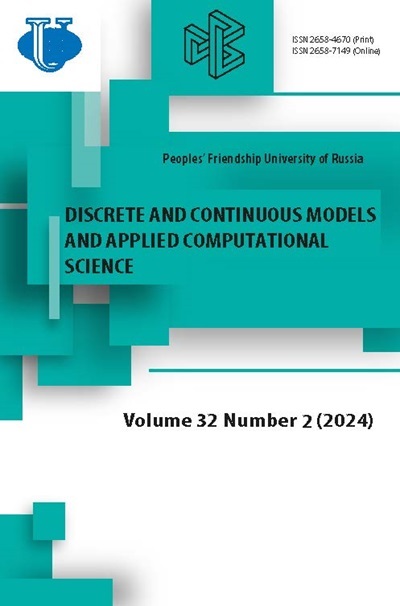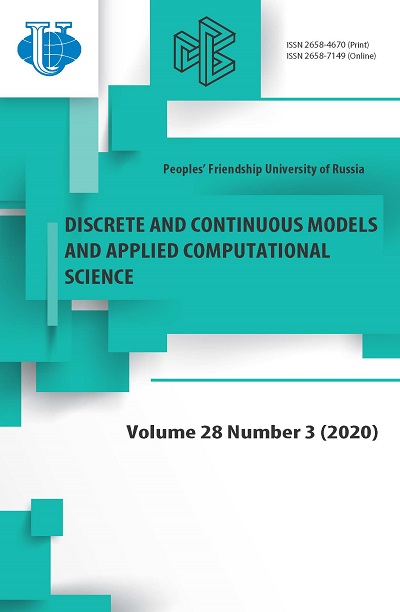Асимптотическое решение задачи Штурма-Лиувилля с периодическими граничными условиями для релятивистского конечно-разностного уравнения Шрёдингера
- Авторы: Амирханов И.В.1, Колосова И.С.2, Васильев С.А.2
-
Учреждения:
- Объединённый институт ядерных исследований
- Российский университет дружбы народов
- Выпуск: Том 28, № 3 (2020)
- Страницы: 230-251
- Раздел: Статьи
- URL: https://journals.rudn.ru/miph/article/view/24704
- DOI: https://doi.org/10.22363/2658-4670-2020-28-3-230-251
Цитировать
Полный текст
Аннотация
Описание взаимодействия релятивистских частиц в рамках квазипотенциального подхода широко применяется в современной физике. Этот подход основан на так называемой ковариантной формулировке квантовой теории поля, в которой эта теория рассматривается на пространственно-подобной трёхмерной гиперповерхности в пространстве Минковского. Особое внимание в этом подходе уделяется методам построения различных квазипотенциалов, а также использованию квазипотенциального подхода для описания характеристик связанных состояний в кварковых моделях, таких как амплитуды адронного упругого рассеяния, масс-спектры и ширины распадов мезонов, сечения глубокого неупругого рассеяния лептонов на адронах.
В настоящей работе сформулированы задачи Штурма–Лиувилля с периодическими граничными условиями на отрезке и на положительной полупрямой для усечённого релятивистского конечно-разностного уравнения Шрёдингера (уравнение Логунова–Тавхелидзе–Кадышевского, LTKT-уравнение) с малым параметром при старшей производной.
Целью работы является построение асимптотических решений (собственных функций и собственных значений) в виде регулярных и погранслойных частей решений для этой сингулярно возмущённой задачи Штурма–Лиувилля. Основная задача исследования состоит в асимптотическом анализе поведенческих решений рассматриваемой задачи в случае ε→0 и m→∞. Нами был предложен метод построения асимптотических решений (собственных функций и собственных значений), который является обобщением асимптотических методов решения сингулярно возмущённых задач, представленных в работах А. Н. Тихонова, А. Б. Васильевой и В. Ф. Бутузова. Основной результат данной работы — доказанные теоремы об асимптотической сходимости решений сингулярно возмущённой задачи к решениям вырожденной задач при ε→0 и сходимости решений усечённого LTKT-уравнения в случае m→∞. Кроме того, в статье нами рассматривается задача Штурма–Лиувилля на положительной полуоси для LTKT-уравнения 4-го порядка с периодическими граничными условиями для квантового гармонического осциллятора. Для этой задачи построены асимптотические приближения собственных функций и собственных значений и показана их сходимость к решению вырожденной задачи.
Об авторах
И. В. Амирханов
Объединённый институт ядерных исследований
Автор, ответственный за переписку.
Email: camir@jinr.ru
Candidate of Physical and Mathemati- cal Sciences, head of the group of Methods for Solving Mathematical Physics Problems of Laboratory of Information Technologies (LIT)
ул. Жолио-Кюри, д. 6, Дубна, Московская область, Россия, 141980И. С. Колосова
Российский университет дружбы народов
Email: i.se.kolosova@gmail.com
PhD’s degree student of Department of Applied Probability and Informatics
ул. Миклухо-Маклая, д. 6, Москва, Россия, 117198С. А. Васильев
Российский университет дружбы народов
Email: vasilyev-sa@rudn.ru
Candidate of Physical and Mathematical Sciences, assistant professor of Department of Applied Probability and Informatics
ул. Миклухо-Маклая, д. 6, Москва, Россия, 117198Список литературы
- A. A. Atanasov and A. T. Marinov, “ℏ-Expansion for bound states described by the relativistic three-dimensional two-particle quasi-potential equation,” Theoretical and Mathematical Physics, vol. 129, no. 1, pp. 1400-1407, 2001. doi: 10.1023/A:1012423629038.
- Y. D. Chernichenko, “On a solution of the relativistic inverse problem for the sum of nonlocal separable quasipotentials,” Russian Physics Journal, vol. 55, no. 6, pp. 699-711, 2012. doi: 10.1007/s11182-012-9869-3.
- V. G. Kadyshevsky, R. M. Mir-Kasimov, and N. B. Skachkov, “Quasipotential Approach and the Expansion in Relativistic Spherical Functions,” Nuovo Cimento A, vol. 55, no. 2, pp. 233-257, 1968. DOI: 10.1007/ BF02759225.
- V. G. Kadyshevsky and M. Mateev, “On a Relativistic Quasipotential Equation in the Case of Particles with Spin,” Nuovo Cimento A, vol. 55, no. 2, pp. 275-300, 1968. doi: 10.1007/BF02759227.
- V. G. Kadyshevsky, “Quasipotential type equation for the relativistic scattering amplitude,” Nuclear Physics, no. 1, pp. 125-148, 1968.
- A. A. Logunov and A. N. Tavkhelidze, “Quasi-optical approach in quantum field theory,” Nuovo Cimento, vol. 29, pp. 380-399, 1963. doi: 10.1007/BF02750359.
- A. A. Logunov and A. N. Tavkhelidze, “Quasi-potential character of the scattering amplitude,” Nuovo Cimento, vol. 30, pp. 134-142, 1963. doi: 10.1007/BF02750754.
- A. A. Logunov, A. N. Tavkhelidze, and O. A. Khrustalev, “Quasipotential character of the Mandelstam representation,” Physics Letters, vol. 4, no. 6, pp. 325-326, 1963.
- V. A. Matveev, V. I. Savrin, A. N. Sissakian, and A. N. Tavkhelidze, “Relativistic Quark Models in the Quasipotential Approach,” Theoretical and Mathematical Physics, vol. 132, no. 2, pp. 1119-1136, 2002. doi: 10.1023/A:1019704709192.
- A. Pokraka and R. Dick, “Dimensional effects on the density of states in systems with quasi-relativistic dispersion relations and potential wells,” Canadian Journal of Physics, vol. 94, no. 8, pp. 773-779, 2016. doi: 10.1139/cjp-2015-0758.
- K. A. Sveshnikov and P. K. Silaev, “Quasi-exact solution of a relativistic finite-difference analogue of the Schrödinger equation for a rectangular potential well,” Theoretical and Mathematical Physics, vol. 132, no. 3, pp. 408-433, 2002. doi: 10.1023/A:1020220104534.
- K. A. Sveshnikov and P. K. Silaev, “Quasi-exact solution of the problem of relativistic bound states in the (1+1)-dimensional case,” Theoretical and Mathematical Physics, vol. 149, no. 3, pp. 1665-1689, 2006. doi: 10.1007/s11232-006-0150-1.
- V. S. Minh, E. P. Zhidkov, and V. G. Kadyshevsky, “Solutions of relativistic radial quasipotential equations,” Theoretical and Mathematical Physics, vol. 63, no. 2, pp. 493-503, 1985. doi: 10.1007/BF01017906.
- I. V. Amirkhanov, E. P. Zhidkov, I. E. Zhidkova, and S. A. Vasilyev, “Construction of an asymptotic approximation of eigenfunctions and eigenvalues of a boundary value problem for the singular perturbed relativistic analog of the Schrödinger equation with an arbitrary potential [Asimptotika sobstvennyh funkcij i sobstvennyh znachenij kraevoj zadachi dlya singulyarno vozmushchennogo relyativistskogo analoga uravneniya Schrödingera pri proizvol’nom potenciale],” Mathematical Models and Computer Simulations [Matematicheskoe modelirovanie], vol. 15, no. 9, pp. 3-16, 2003, in Russian.
- I. V. Amirkhanov, E. P. Zhidkov, D. Z. Muzafarov, N. R. Sarker, I. Sarhadov, and Z. A. Sharipov, “Investigation of boundary-value problems for the singular perturbed differential equation of high order [Issledovanie kraevyh zadach dlya singulyarno-vozmushchennogo differencial’nogo uravneniya vysokogo poryadka],” Mathematical Models and Computer Simulations [Matematicheskoe modelirovanie], vol. 19, no. 11, pp. 65-79, 2007, in Russian.
- I. V. Amirkhanov, N. R. Sarker, I. Sarhadov, Z. K. Tukhliev, and A. Sharipov, “Analytical and Computational Investigations of Solutions of Boundary-Value Problems for the Quasipotential Equation [Analiticheskoe i chislennoe issledovaniya reshenij kraevyh zadach dlya kvazipotencial’nogo uravneniya],” Bulletin of Peoples’ Friendship University of Russia. Series Mathematics. Information Sciences. Physics [Vestnik Rossijskogo universiteta druzhby narodov. Seriya: Matematika, informatika, fizika], no. 4, pp. 44-52, 2012, in Russian.
- V. O. Galkin, R. N. Faustov, and D. Ebert, “Logunov-Tavkhelidze equation in the relativistic quark model,” Theoretical and Mathematical Physics, vol. 191, no. 2, pp. 641-648, 2017. DOI: 10. 1134/S0040577917050038.
- N. Alam and S. Mandal, “On the quantum phase fluctuations of coherent light in a chain of two anharmonic oscillators coupled through a linear one,” Optics Communications, vol. 366, pp. 340-348, 2016. DOI: 10. 1016/j.optcom.2016.01.019.
- Z. Chen, “Mapping quantum many-body system to decoupled harmonic oscillators: general discussions and examples,” Physics Letters A, vol. 382, no. 37, pp. 2613-2617, 2018. doi: 10.1016/j.physleta.2018.07.043.
- E. P. Zhidkov, V. G. Kadyshevsky, and Y. V. Katyshev, "Problem of the c→∞ limit in the relativistic Schrodinger equation," Theoretical and Mathematical Physics, vol. 3, no. 2, pp. 443-446, 1970. doi: 10.1007/BF01046508.
















